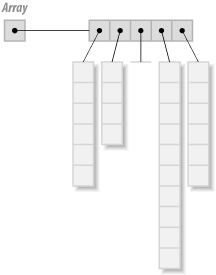Recipe 7.15 Multidimensional Structures
ProblemYou need a two-, three-, or more dimensional array or ArrayList. SolutionNo problem. Java supports this. DiscussionAs mentioned back in Recipe 7.1, Java arrays can hold any reference type. Since an array is a reference type, it follows that you can have arrays of arrays or, in other terminology, multidimensional arrays. Further, since each array has its own length attribute, the columns of a two-dimensional array, for example, do not all have to be the same length (see Figure 7-2). Here is code to allocate a couple of two-dimensional arrays, one using a loop and the other using an initializer. Both are selectively printed: /** Show Two-Dimensional Array of Objects */ public class ArrayTwoDObjects { /** Return list of subscript names (unrealistic; just for demo). */ public static String[][] getArrayInfo( ) { String info[][]; info = new String[10][10]; for (int i=0; i < info.length; i++) { for (int j = 0; j < info[i].length; j++) { info[i][j] = "String[" + i + "," + j + "]"; } } return info; } /** Return list of allowable parameters (Applet method). */ public static String[][] getParameterInfo( ) { String param_info[][] = { {"fontsize", "9-18", "Size of font"}, {"URL", "-", "Where to download"}, }; return param_info; } /** Run both initialization methods and print part of the results */ public static void main(String[] args) { print("from getArrayInfo", getArrayInfo( )); print("from getParameterInfo", getParameterInfo( )); } /** Print selected elements from the 2D array */ public static void print(String tag, String[][] array) { System.out.println("Array " + tag + " is " + array.length + " x " + array[0].length); System.out.println("Array[0][0] = " + array[0][0]); System.out.println("Array[0][1] = " + array[0][1]); System.out.println("Array[1][0] = " + array[1][0]); System.out.println("Array[0][0] = " + array[0][0]); System.out.println("Array[1][1] = " + array[1][1]); } }Figure 7-2. Multidimensional arrays Running it produces this output: > java ArrayTwoDObjects Array from getArrayInfo is 10 x 10 Array[0][0] = String[0,0] Array[0][1] = String[0,1] Array[1][0] = String[1,0] Array[0][0] = String[0,0] Array[1][1] = String[1,1] Array from getParameterInfo is 2 x 3 Array[0][0] = fontsize Array[0][1] = 9-18 Array[1][0] = URL Array[0][0] = fontsize Array[1][1] = - > The same kind of logic can be applied to any of the Collections. You could have an ArrayList of ArrayLists, or a Vector of linked lists, or whatever your little heart desires. As Figure 7-2 shows, it is not necessary for the array to be "regular." That is, it's possible for each column of the 2D array to have a different height. That is why I used array[0].length for the length of the first column in the code example. |
EAN: 2147483647
Pages: 409
- ERP Systems Impact on Organizations
- Challenging the Unpredictable: Changeable Order Management Systems
- Context Management of ERP Processes in Virtual Communities
- Healthcare Information: From Administrative to Practice Databases
- Relevance and Micro-Relevance for the Professional as Determinants of IT-Diffusion and IT-Use in Healthcare